Alcohol and late night refreshment licensing: statistical news release
Published 25 October 2012
Applies to England and Wales
1. Overview
This document contains briefings giving detailed information on a range of local powers, and activity during the 12 months to 31 March 2012 is available within the following 6 topics:
- Premises licences briefing and premises licences excel tables are provided on the number of premises licences in force on 31 March 2012, and the numbers applied for, granted and refused in the previous 12 months.
- Club premises certificates and club premises certificates excel tables are provided on the number of club premises certificates in force on 31 March 2012, and the numbers applied for, granted and refused in the previous 12 months.
- Personal licences briefing and personal licences excel tables are provided on the number of personal licenses in force on 31 March 2012, and the numbers applied for, granted and refused in the previous 12 months.
-
Late night refreshment and 24-hour alcohol licence briefing and
late night refreshment and 24-hour alcohol licences excel tables are provided on the number of licenses for after hours sales of alcohol or hot food and drink in force on 31 March 2012. - Reviews, hearings and appeals briefing and reviews, hearings and appeals excel tables are provided on the number of reviews conducted into licensed or certificated premises and completed in the 12 months to 31 March 2012, and the outcome of these reviews. It also contains summary figures on expedited reviews and hearings, appeals and judicial reviews.
- Other topics briefing and other topics excel tables are provided on the number of cumulative impact areas identified by local authorities on 31 March 2012; and the number of temporary event notices issued in the 12 months to 31 March 2012.
2. Premises licences
2.1 Introduction
Statistics are presented here on the numbers of premises licences issued by the licensing authorities (LAs) in England and Wales that were in force on 31 March 2012, and comparisons with 31 March 2010, the last date for which data were collected. These headline figures combine the data received from 336 of the 350 LAs (96%) with estimates for the remaining authorities.
A premises licence gives authority for a premises to be used for the sale or supply of alcohol, the provision of regulated entertainment, or the provision of late night refreshment.
Also presented here are breakdowns of numbers of licensing returns in force on 31 March 2012 by fee band, plus the numbers applied for, granted or refused in the 12 months to 31 March 2012 (2011/12). The response rate for these details is lower than for the overall licence total, as some authorities have submitted an incomplete return. Here, as the figures are smaller and more disaggregated, it is not possible to produce reliable estimates for non-response.
The User Guide to Alcohol and Late Night Refreshment Licensing Statistics provides further details relating to definitions, methodology and data quality.
2.2 Key facts
Based on the actual returns and the estimates for non-response, there were 202,000 premises licences in force in England and Wales on 31 March 2012. This is the same as on 31 March 2010 but 2 per cent more than 31 March 2009 (198,000) and 3 per cent more than 31 March 2008 (195,800).
Within the 2012 total:
- 35,500 premises were licensed for on-sales of alcohol only (up one per cent on 2010);
- 51,100 premises were licensed for off-sales or supply of alcohol only (up five per cent); and
- 82,900 premises were licensed for on- or off-sales or supply (up one per cent).
- The remaining 32,500 premises were not permitted to sell alcohol, down 9 per cent on 2010
2.3 Data tables
Key data on premises licences, including estimates for non-response, can be found in the following tables:
The full breakdowns of the premises licences totals exclude estimates for non-response, and are therefore based solely on the returns received from the LAs in England and Wales. They can be found in the following tables:
2.4 Premises licences by fee band
Based only on the returns received from 336 of the 350 licensing authorities, there were 188,592 premises licences in force on 31 March 2012. Of this total, there were 154,884 licences where the fee band information was provided.
When setting fees, premises are grouped together in bands according to their non-domestic rateable value. The amounts of these fees in each band are listed in the user guide.
Over 3-quarters of these premises licences were on fee bands A or B. There were 33,358 or 22 per cent of the total in band A and 83,046 or 54 per cent in band B.
Within the overall total, 11,181 licences did not attract a fee, even though a fee band was set.
Premises licenses by fee band, England and Wales, 31 March 2012

Premises licenses by fee band, England and Wales, 31 March 2012.
Chart notes
Explanation of the fee band process appears in the glossary of the user guide. Fee bands D and E contain licences for premises where fee multipliers are applied. The percentages in the pie chart may not add up to 100 per cent due to rounding.
Source: Home Office, Alcohol and Late Night Refreshment Licensing England and Wales 2011/12 tables.
2.5 Premises licence activity and outcome
Based only on the 327 out of 350 LAs (93%) who provided data, there were 10,161 new premises licences applied for, of which 9,380 were granted (97% of all decided outcomes) and 338 were refused. Newly granted premises licences accounted for around 5 per cent of the total number of premises licences in force on 31 March 2012.
There were 6,812 variation applications made to change the terms of a licence, of which 6,298 were granted (97% of all decided outcomes), and 196 refused (3%).
There were 6,027 minor variation applications made to permit low risk changes to the terms of a licence or certificate, of which 5,667 were granted (95% of all decided outcomes), and 267 refused (4%). [N.B. These figures do not distinguish between premises licences and club premises certificates.]
Of the remaining types of change in 2011/12:
- 4,386 premises licences were surrended by the holder;
- 493 lapsed;
- one was suspended by the court; and
- 92 were affected by a closure notice.
All of the activity types are defined in the glossary within the user guide.
Date: Thu Oct 25 09:30:00 BST 2012
3. Club premises certificates
3.1 Introduction
Statistics are presented here on the numbers of club premises certificates issued by the licensing authorities (LAs) in England and Wales that were in force on 31 March 2012, and comparisons with 31 March 2010, the last date for which data were collected. These headline figures combine the data received from 336 of the 350 LAs (96%) with estimates for the remaining authorities.
A club premises certificate allows a qualifying club to carry out activities specified under the Licensing Act 2003. These activities, and how a club qualifies, are described in the user guide.
Also presented here are breakdowns of numbers of licensing returns in force on 31 March 2012 by fee band, plus the numbers applied for, granted or refused in the 12 months to 31 March 2012 (2011/12). The response rate for these details is lower than for the overall licence total, as some authorities have submitted an incomplete return. Here it is not possible to produce reliable estimates for non-response.
The user guide provides further details relating to definitions, methodology and data quality.
3.2 Key facts
Based on the actual returns and the estimates for non-response , there were 15,900 club premises certificates in force in England and Wales on 31 March 2012, down 6 per cent on the 17,000 on 31 March 2010. Numbers fell in the previous 2 years, and consequently there were ten per cent fewer certificates in force in 2012 than in 2008.
Within the 2012 total:
- 7,400 club premises were certificated for on-sales of alcohol only (down five per cent on 2010); and
- 8,400 premises were licensed for on- or off-sales or supply of alcohol (down 6 per cent).
- The remaining 100 premises were not permitted to sell alcohol.
3.3 Data tables
Key data on club premises certificates, including estimates for non-response, can be found in the following tables:
The full breakdowns of the club premises certificates totals exclude estimates for non-response, and are therefore based solely on the returns received from the LAs in England and Wales. They can be found in the following tables:
3.4 Club premises certificates by fee band
Based only on the returns received from 332 of the 350 licensing authorities, there were 15,106 club premises certificates in force on 31 March 2012. Of this total, there were 12,261 where the fee band information was provided.
When setting fees, premises are grouped together in bands according to their non-domestic rateable value. The amounts of these fees in each band are listed in the user guide.
More than 9 in ten of these club premises certificates were in fee bands A or B. There were 3,642 or 30 per cent of the total in band A and 7,592 or 62 per cent in band B.
Within the overall total, 115 licences did not attract a fee, even though a fee band was set.
Club premises certificates by fee band, England and Wales, 31 March 2012
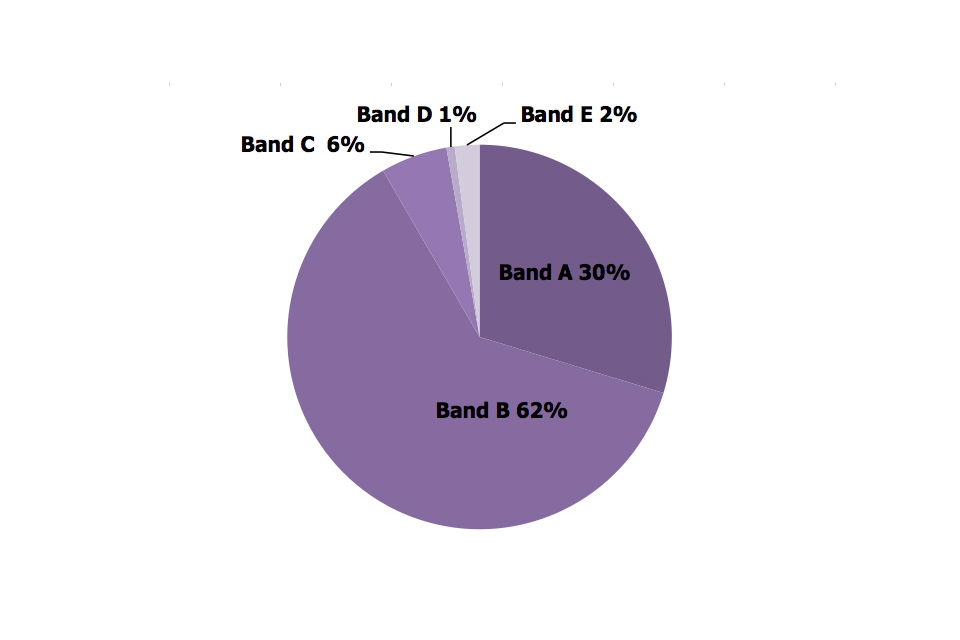
Club premises certificates by fee band, England and Wales, 31 March 2012.
Chart notes
Explanation of the fee band process appears in the glossary of the user guide.
Source: Home Office, Alcohol and Late Night Refreshment Licensing England and Wales 2011/12 tables.
3.5 Club premises certificates by change and outcome
Figures in this section exclude estimates for non-response.
In 2011/12 there were 159 new club premises certificates applied for, of which 148 were granted (97% of all decided outcomes) and 4 were refused (3%). Newly granted certificates accounted for around one per cent of the total number of club premises certificates in force on 31st March 2012.
There were 179 variation applications made to change the terms of a certificate, of which 172 were granted (97% of all decided outcomes), and 6 refused (3%).
There were 6,027 minor variation applications made to permit low risk changes to the terms of a licence or certificate, of which 5,667 were granted (95% of all decided outcomes), and 269 refused (5%). [NB These figures do not distinguish between premises licenses and club premises certificates.]
Of the remaining types of change in 2011/12:
- 272 club premises certificates were surrended by the club;
- 26 lapsed; and
- 12 were withdrawn.
All of the activity types are defined in the glossary within the user guide.
4. Personal licences
Valid: 25 October 2012 to October 2013 (prov)
4.1 Introduction
Statistics are presented here on the numbers of personal licences issued by the licensing authorities in England and Wales that were in force on 31 March 2012, and comparisons with 31 March 2010, the last date for which data were collected. These figures combine the data received from 336 of the 350 licensing authorities (96%) plus estimates for the remaining authorities.
A personal licence authorises an individual to supply or authorise the supply of alcohol in accordance with a premises licence under the Licensing Act 2003.
The user guide provides further details relating to definitions, methodology and data quality.
4.2 Key facts
There were 502,400 personal licences in force in England and Wales on 31st March 2012, 16 per cent more than the 434,200 on 31 March 2010 (includes estimates for non-response).
Estimated number of personal licences, England and Wales, 2008 to 2012
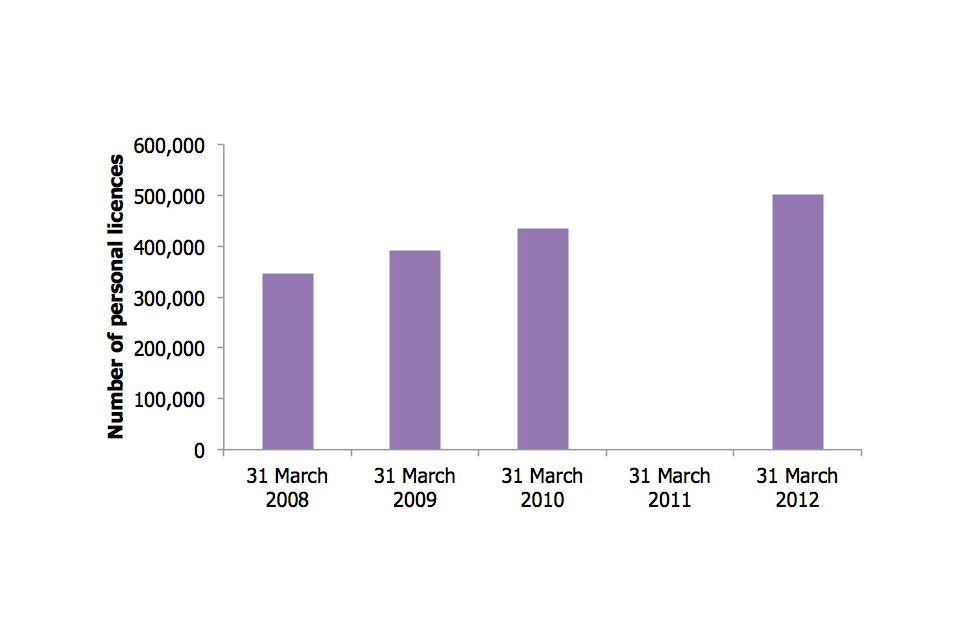
Estimated number of personal licences, England and Wales, 2008 to 2012.
Chart notes
Data not collected for 31 March 2011.
Source: Home Office, Alcohol and Late Night Refreshment Licensing England and Wales 2011/12 tables.
4.3 Data tables
Data on personal licences, sourced from returns received from 336 of the 350 licensing authorities (96%) in England and Wales, plus estimates for the remaining authorities, can be found at Alcohol and Late Night Refreshment Licensing England and Wales 2011/12 tables.
4.4 Personal licences activity
The following results are based only on the completed returns received and will be an underestimate of the full picture in England and Wales.
The act provides the police and licensing authorities with powers to deal with errant personal licence holders. In the year to 31st March 2012: 258 personal licences were surrendered (based on 94% of all LAs); 25 were revoked; 8 were forfeited; and 14 were suspended by a court (based on 92% of all LAs).
There were 612 committee hearings following a personal licence application (based on 93% of all LAs).
5. Late night refreshment and 24-hour alcohol licence briefing
5.1 Introduction
Statistics are presented here on the numbers of premises licences with late night refreshment and on 24-hour alcohol licences issued by the licensing authorities in England and Wales that were in force on 31 March 2012, and comparisons with 31 March 2010, the last date for which data were collected. These figures combine the data received from 336 of the 350 licensing authorities (96%), plus estimates for the remaining authorities.
A premises licence authorises a premises to be used for the sale or supply of alcohol, the provision of regulated entertainment or the provision of late night refreshment under the Licensing Act 2003.
A 24-hour licence refers to premises that are licensed for the sale or supply of alcohol for 24 hours in their standard timing.
Late night refreshment refers to the provision of hot food or drink to the public, for consumption on or off the premises, between 11pm and 5am or the supply of hot food or hot drink to any persons between those hours on or from premises to which the public has access.
The User Guide to Alcohol and Late Night Refreshment Licensing Statistics provides further details relating to definitions, methodology and data quality.
5.2 Key facts
There were 8,400 premises with 24-hour alcohol licences in force in England and Wales on 31 March 2012, 8 per cent more than the 7,800 on 31 March 2010 (includes estimates for non-response).
The estimated number of 24-hour alcohol licences have increased year on year since the introduction of the Licensing Act 2003. Since 2010, the largest increases were in other premise types (up 300 or 38%) and supermarkets and stores (up 300 or 18%). Since 2010, the estimated number of 24-hour alcohol licences for hotel bars increased (up 100 or 2%) and for pubs, bars and nightclubs remained stable.
There were 87,300 premises with late night refreshment in force in England and Wales on 31 March 2012, 3 per cent more than the 84,900 on 31 March 2010 (includes estimates for non-response).
Estimated number of 24-hour alcohol licences, England and Wales, 2008 to 2012
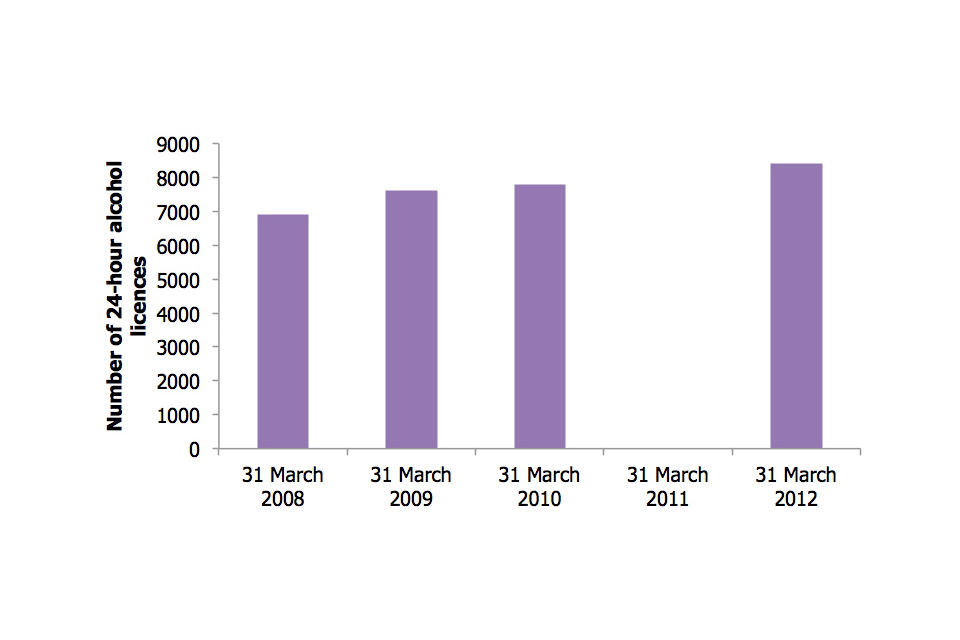
Estimated number of 24-hour alcohol licences, England and Wales, 2008 to 2012.
Chart notes
Data not collected for 31 March 2011.
Source: Home Office, Alcohol and Late Night Refreshment Licensing England and Wales 2011/12 tables.
Estimated number of late night refreshment licences, England and Wales, 2008 to 2012

Estimated number of late night refreshment licences, England and Wales, 2008 to 2012.
Chart notes
Data not collected for 31 March 2011.
Source: Home Office, Alcohol and Late Night Refreshment Licensing England and Wales 2011/12 tables.
5.3 Data tables
Data on premises licences with late night refreshment and 24-hour alcohol licences, sourced from returns received from 336 of the 350 licensing authorities (96%) in England and Wales, plus estimates for the remaining authorities, can be found at: Alcohol and Late Night Refreshment Licensing England and Wales 2011/12 tables.
5.4 Late night refreshment
The following results are based only on the completed returns received and will be an underestimate of the full picture in England and Wales.
75,388 premises licences (4 in 10 of all premises licences in force) had late night refreshment activity authorised (based on 90% of all LAs).
Of these, 16,772 premises had only late night refreshment activity authorised (based on 89% of all LAs).
5.5 24-hour alcohol licences
The following results are based only on the completed returns received and will be an underestimate of the full picture in England and Wales.
Ninety-three per cent of LAs submitted a total for 24-hour alcohol licences. There were 7,109 premises licensed for the sale or supply of alcohol for 24 hours in their standard timings, on 31 March 2012. They represent just under 4 per cent of all premises licences and club premises certificates authorised to sell alcohol. The possession of a 24-hour licence does not necessarily mean that the premises will choose to open for 24 hours.
Prior to the 2003 Act, hotels were authorised to sell alcohol to residents and their private guests only, outside of permitted licensing hours and were able to apply to keep this provision under ‘grandfather rights’. Around 54 per cent of all 24-hour alcohol licences were in hotel bars (3,780), of which around 86 per cent were open to guests only and the remaining 14 per cent open to guests and the public (based on 90% of all LAs). A large number of hotels are located in leisure resort areas and therefore these areas would also have a large proportion of hotel bars with 24-hour alcohol licences for guests.
There were 1673 supermarkets and stores with 24-hour alcohol licences (based on 92% of all LAs), of which 52 per cent were large supermarkets and the remaining 48 per cent were other convenience stores.
There were 739 other premises types licensed for the sale or supply of alcohol for 24 hours. This category included casinos, warehouses, village halls, cafés and restaurants, cinemas, holiday camps, and private member clubs as well as various other premises types (based on 89% of all LAs).
Premises with 24-hour alcohol licences by premises type, England and Wales, 31 March 2012
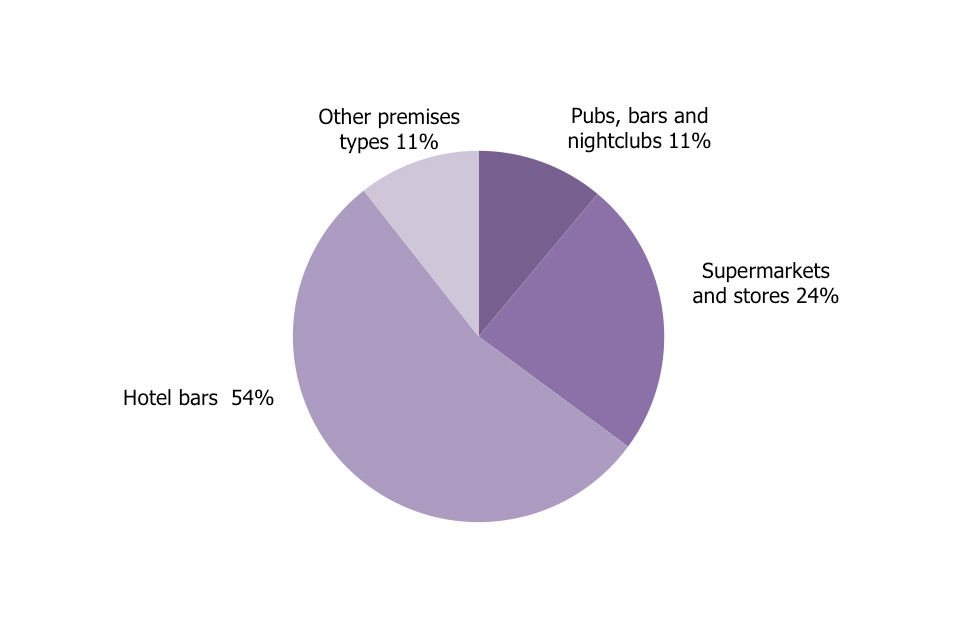
Premises with 24-hour alcohol licences by premises type, England and Wales, 31 March 2012.
Chart notes
Source: Home Office, Alcohol and Late Night Refreshment Licensing England and Wales 2011/12 tables
6. Reviews, Hearings and Appeals
6.1 Introduction
Statistics are presented here on the numbers of completed reviews conducted by the licensing authorities (LAs) in England and Wales during 2011/12, and comparisons with 2009/10, the last period for which data were collected. These headline figures combine the data received from 336 of the 350 LAs (96%) with estimates for the remaining authorities.
Also presented here are breakdowns of numbers of reviews completed in 2011/12, by type of licence reviewed, reason for review, the instigating body, and the actions taken following the review. There are also sections on the interim steps taken after expedited reviews, the numbers of appeals against application and review decisions, the number of applications that went to a hearing, and the number of completed judicial reviews. The response rates for these details are lower than for the overall licence total, as some authorities have submitted an incomplete return. Here, as the figures are smaller and more disaggregated, it is not possible to produce reliable estimates for non-response.
The User Guide to Alcohol and Late Night Refreshment Licensing Statistics provides further details relating to definitions, methodology and data quality.
6.2 Key facts
Based on the actual returns and the estimates for non-response, there were 1,100 reviews completed in 2011/12, 15 per cent fewer than the 1,300 completed in 2009/10.
6.3 Data tables
Data on reviews, hearings and appeals sourced from returns received from 336 of the 350 licensing authorities (96%) in England and Wales, plus estimates for the remaining authorities, can be found at: Alcohol and Late Night Refreshment Licensing England and Wales 2011/12 tables
6.4 Completed reviews
A licensing authority can be asked to review a licence by those living or working in the vicinity of premises who are complaining of adversely being affected by the operation of the licence. The requirement to live in the vicinity was removed on 25 April 2012 and therefore may impact on the next year’s figures. The figures in this section refer to those reviews that were completed in 2011/12.
Eighty per cent of authorities were also able to provide the information on type of licence reviewed. Based on these reviews:
- 786 (85%) were for premises licences following a general application for a review
- 122 (13%) were for premises licences following an application by police for an expedited review
- 11 (1%) were for premises licences following a closure order
- 10 (1%) were for club premises certificates
Eighty per cent of LAs were also able to provide the main reason or reasons for completed reviews (as reported by the licensing objectives and the stated grounds of the review). The reasons cited were crime and disorder (646 reviews, cited in 64% of reviews), followed by public nuisance (309 reviews, 30%), protection of children (292, 29%) and public safety (186, 18%). As more than one reason was cited by some authorities, the percentages sum to more than 100.
Seventy-nine per cent of authorities also provided a breakdown of the persons or organisations that instigated the reviews and the proportions are shown in the chart. The police were the main responsible authority, instigating 575 reviews or 61 per cent of the total. The ‘Other’ category includes the Fire and Rescue Authorities, Residents’ Associations, members of the public (apart from individual local residents) and local businesses.
Completed reviews instigated by responsible authority, England and Wales 2011/12

Completed reviews instigated by responsible authority, England and Wales 2011/12.
Chart notes
Source: Home Office, Table 12 Alcohol and Late Night Refreshment Licensing England and Wales 2011/12 tables
Eighty-six per cent of authorities provided a breakdown of types of action taken following the reviews completed in 2011/12, and these are portrayed in the bar chart below. In 6 per cent of the 1,015 reviews where this information was provided, no action was taken following the competed review. In contrast, 18 per cent of reviews resulted in a revocation of licence or withdrawal of certificate; and another 13 per cent resulted in a licence or certificate being suspended. The remaining actions ranged from restrictions or exclusion of activities to modification of opening hours.
Actions taken following completed reviews, England and Wales 2011/12
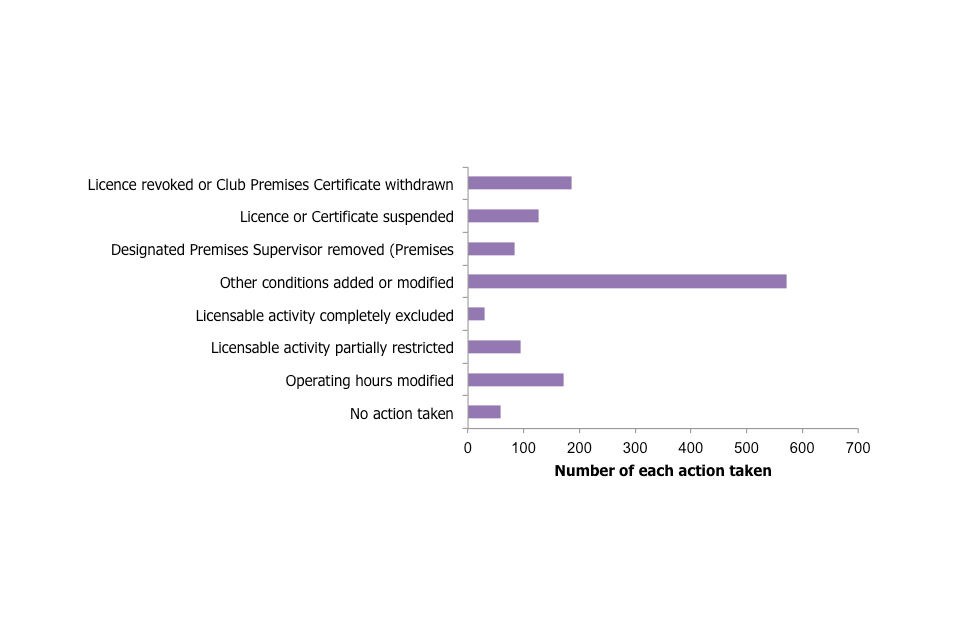
Actions taken following completed reviews, England and Wales 2011/12.
Chart notes
Source: Home Office, Table 13 Alcohol and Late Night Refreshment Licensing England and Wales 2011/12 tables
6.5 Expedited reviews
Expedited review powers allow the police to trigger a fast-track process to review a premises licence where the police consider that the premises are associated with serious crime or serious disorder (or both); and the licensing authority to respond by taking interim steps quickly, where appropriate, pending a full review.
Based on 92 per cent of authorities who provided data on expedited reviews, there were 140 applications by the chief officer of police in 2011/12 for an expedited/summary review of a premises licence because of serious crime and/or serious disorder under s.53A of the 2003 Act. 3 of these applications were withdrawn or rejected.
In 125 expedited reviews, interim steps were taken following the successful application for the review. Interim steps are temporary measures which have to be taken within 48 hours of the expedited review being accepted under one specific review power. These measures then fall (unless they are re-imposed at the review hearing). In 13 cases, no interim steps were taken.
Where interim steps were taken:
- in 71 cases the interim step was to suspend the premises licence
- in 24 cases, it was to modify the operating hours (83% of all LAs)
- in 55 cases other conditions were added or modified
- in 23 cases the Designated Premises Supervisor was removed
6.6 Hearing, appeals and judicial reviews
Licensing authorities have one month, following the end of the advertising period, to hold a hearing to consider the review application. The applicant for the review, the premises licence holder and any person who submitted a representation all have a right of appeal against the panel’s decision.
In 2011/12 there were 3,378 premises licence or club premises certificate applications that went to a committee hearing (based on data from 91% of all LAs). These include applications that went to a hearing for a premises licence, provisional statements, club premises certificates or to vary a licence. There were also 612 personal licence applications that went to a hearing.
Based on data from 93 per cent of all LAs, over the same period there were 97 completed appeals against the application decision (where the magistrates’ court notified parties of its decision in the time period specified). There were also about 137 completed appeals against the licence review decision. In this period there were nearly 230 licensing authorities that had not reported a single appeal against any decision.
There were 3 completed judicial reviews in the higher courts during 2011/12 (based on data from 93% of all LAs).
The user guide provides further details relating to definitions, methodology and data quality.
7. Other topics
7.1 Introduction
Statistics are presented below on the numbers of cumulative impact areas identified by local authorities on 31 March 2012; and the number of temporary event notices (TENs) issued in the 12 months to 31 March 2012. These figures combine the data received from 336 or 96 per cent of the 350 licensing authorities, and in the case of TENs an estimate for non-response can be added.
A cumulative impact area is an area that the Licensing Authority has identified in their licensing policy statement where there is a saturation of licensed premises and the ‘cumulative impact’ of any additional licensed premises could affect the licensing objectives.
TENs are used to authorise certain relatively small-scale events involving licensable activities, subject to certain criteria and limits.
The user guide provides further details relating to definitions, methodology and data quality.
7.2 Key facts
Based on the actual data from 94 per cent of the LAs, there were 160 Cumulative Impact Areas in place on 31 March 2012.
Based on the actual returns and the estimates for non-response, there were 134,100 TENs used in 2011/12, 8 per cent more than in 2009/10.
7.3 Data tables
Data on cumulative impact areas (CIA) and temporary event notices sourced from returns received from 336 of the 350 licensing authorities (96%) in England and Wales, plus estimates for the remaining authorities, can be found at: [Alcohol and Late Night Refreshment Licensing England and Wales 2011/12 tables][3] . The tables also contain extra details on numbers of TENs modified or withdrawn.
8. Further information
Information about each topic is available in the User Guide to Alcohol and Late Night Refreshment Licensing Statistics. The guide contains a glossary of terms, notes on interpreting the figures, and information on sources of data on other police powers.
This release in part replaces the previous Department of Culture, Media and Sport (DCMS) Bulletin on Alcohol, Entertainment and Late Night Licensing, the most recent of which was published for 2009/10. Despite the change in mode of publication the summary text and tables are broadly similar.
Datasets at Licensing Authority level, County and Region are provided as supplementary tables.
Figures for entertainment licensing in 2011/12 will be published in due course by DCMS, and a link will appear here.
Future editions of this annual release will be published on dates announced via the UK Statistics Authority’s Publication Hub: Release Calendar.
Date: Thu Oct 25 09:30:00 BST 2012
